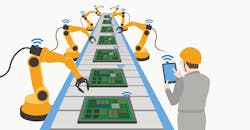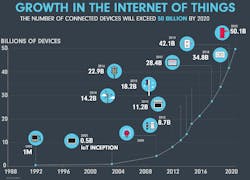Internet of Things Is Boosting Industry, But Will It Help Economy?
Author: Craig Torres
In the world of making everyday life more digital, something is starting to tip. You can see it at Noyes Air Conditioning Inc. on Monday mornings.
They used to be a nightmare, as recently as 2013, says General Manager Chris Kaufman in Gaithersburg, Maryland. Seventy technicians would dump a week’s worth of service tickets on accountants who’d then scramble to get invoices and payroll out. It was “really killing us,” Kaufman said. Then he found Canvas Solutions Inc., a startup that specializes in online workflow documentation. Now, everything’s done on iPads and the cloud.
That’s just one example of how technology is starting to reach into neglected corners of the economy -- as it’s long promised to do. From plumbers’ trucks to public transportation, and even those endless forms you fill out before seeing a doctor, startup companies are finding ways to digitize ordinary tasks that have escaped the attention of giants such as Amazon.com Inc. and Microsoft Corp.
By doing so, they might even revive U.S. productivity, healing one of the deepest wounds of the Great Recession -- one frequently lamented by Federal Reserve board members, who wrap up a two-day policy meeting today. Some economists doubt the latest tech gimmicks are up to that task, and debate is raging on the subject. But there’s plenty of money lined up behind the techno-optimists, who say the Internet of Things and its spinoffs are only just getting going.
“We are now two or three years into what is going to be the dominant investment cycle for the next 10 or 15 years,” said Evan Burfield, co-founder of 1776, a startup incubator in Washington. He calls it “applying technology to the other 80 percent of problems.”
Scaled down, that could describe what Reston, Virginia-based Canvas is doing. Its digital forms, for everything from nail salons to pest control, make ordinary workflow faster and smarter by putting information about businesses or their customers online so it can be stored, transferred and recalled.
When a Noyes technician arrives on a job now, the head office has already filled out a digital ticket. After finishing work, techs hit the microphone button on the iPad and recite the details. Then they hit a location button to show clients and managers they were there. Information on billing and hours worked is collected off the cloud daily.
“Most of the world has been working off a clipboard for 100 years,” says Joshua Konowe, chief product officer at Canvas, whose clients also include Red Bull GmbH and Target Corp. He invokes an old dream that might finally be happening: “We’re trying to take paperwork and get rid of it.”
‘Huge’ Gains
Or consider TransitScreen Inc. The three-year-old Washington startup, whose investors include 1776, scoops up data on transportation available in a given location, from a Car2Go to bike shares to Uber, Lyft, buses and trains. Anyone who lives or works near one of its 1,000 installed screens -- or just walks by -- can see all their options at once.
Or Payzer LLC, based in Charlotte, North Carolina, which has developed a cloud-based mobile accounting and payments system. Service companies that use it -- including Bud’s Plumbing, Heating, and Air Conditioning -- can process checks or swipe credit cards on site using digital devices, instead of dropping payments off at the office each evening. Fuel savings alone are “huge,” says Chris Klijanowicz, chief financial officer at Bud’s in Yorktown, Virginia.
If the diffusion of such handy tools seems slow, the Great Recession is partly to blame, according to Don Rainey, a partner at Grotech Ventures in Vienna, Virginia, which invested in Payzer. It ended in 2009 but killed off risk-taking for years afterwards: Startup activity in 2013 fell to the lowest levels in records going back to 1996. Now it’s bouncing back.
“Americans were culturally shaken,” Rainey says. “The game that entrepreneurs play is a mix of hard work and cleverness. When your variables are mixed up, all the calculus is skewed.”
Seven years later, the economic underpinnings look more supportive. Unemployment is low, providing entrepreneurs who fail with the safety net of a strong job market. Household net worth, which took five years to recover from its pre-recession peak, now stands at a record high of $89 trillion. That’s important because most tech entrepreneurs initially finance their ideas out of their own pockets.
Away from the macro-economy, there are other reasons why change is coming now. Mobile phones have saturated the market and component makers are looking for new places to apply their gadgetry; networks have also improved.
Of course, the spread of data could be a gift to hackers, as October’s attack on servers showed. And that’s driving a secondary wave of startups.
“The advent of the Internet of Things is a catalyzing factor in the adoption of cybersecurity products,” says Rick Gordon, managing partner at Mach37, a Herndon, Virginia, accelerator that invests in such businesses.
Will It Help?
How much will all this innovation help the broader economy, though? That’s a live question among economists trying to take the long view, and it hinges on productivity, a measure of whether a given meld of capital, regulation and labor is working well. When productivity grows fast, it makes nations rich, and allows companies to boost pay without raising prices.
In America right now, it’s growing slowly or not at all: The average pace was just 0.29 percent in the past 12 quarters, according to the Federal Reserve Bank of San Francisco, a dismal performance by past standards.
That’s grist for the mill of Robert Gordon, who’s become the doyen of the techno-pessimists. His recent book “The Rise and Fall of American Growth” argued that there probably won’t be a repeat of the 1994-2004 boom in productivity, let alone the eras that saw the spread of railroads, telephones or home appliances. The infusion of technology into ordinary things will be slow, and the gains incremental.
On the other side are Erik Brynjolfsson and Andrew McAfee, authors of “The Second Machine Age,” published in 2014. It predicted that the new wave of digitization will be “profoundly beneficial.”
At Cisco Systems Inc. in San Jose, California, Rowan Trollope is well placed to score the debate. He’s in charge of the company’s Internet-of-Things business and acknowledges that for years now the tech industry has delivered “hype, and hype, and hype” about productivity gains that have yet to arrive. He says he used to walk into Best Buy stores and wonder: Where are all the connected things? There weren’t any, except maybe a thermostat.
Happening Now
But the revolution is under way at last, Trollope says.
In each of the past eight quarters, AT&T Inc. has added more devices to its network than phones or tablets. In total the company now has 30.3 million devices online, including watches, refrigerators, shipping containers and 10.5 million cars, said spokesman Fletcher Cook.
And as objects go online, they’re able to learn and update themselves, to become faster, smarter or more productive. Their makers have to become software companies, too. A “tune-up” on a Tesla car involves a download.
Technology has changed business models in retailing, media and communications. Startups such as Canvas and Payzer are injecting it into everyday services. And now it’s started to seep into manufactured things, “the widgets,” Trollope said. “This is the beginning of the beginning.”
--With assistance from Catarina Saraiva

